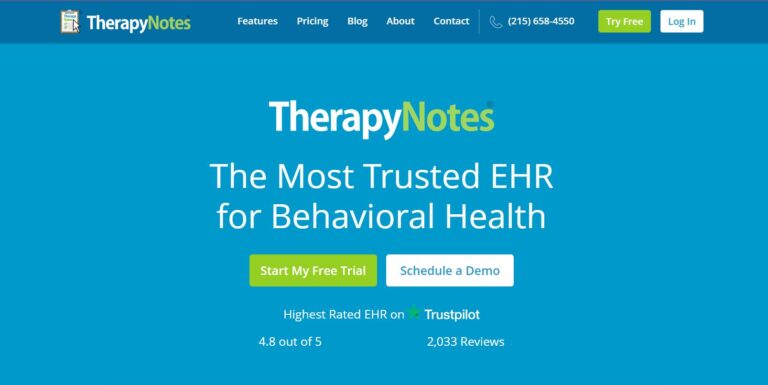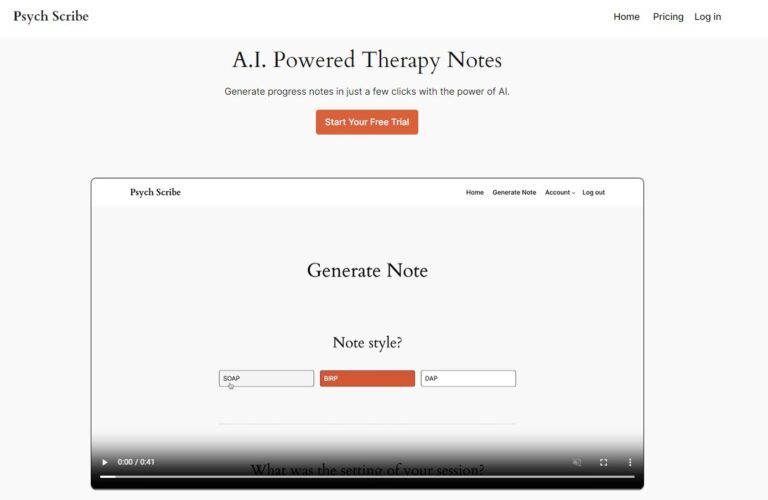BirpNotes
Streamline mental health documentation, focusing on patient behavior, interventions, response, and planning for effective, personalized care.
Mental health documentation is an integral part of therapy that ensures continuity of care and tracks a client’s progress. Among the various formats used for documentation, BIRP notes stand out for their structure and clarity.
What is BIRP?
BIRP is an acronym representing Behavior, Intervention, Response, and Plan. This format provides a structured method for therapists to document clinical sessions. It helps in organizing the therapist’s observations and interventions in a coherent manner, which is crucial for effective treatment planning and legal documentation.
Top BIRP Notes Apps
-
Blueprint
In the last 3 years lots of online AI tools for therapists have been introduced in the market like Upheal, Mentalyc, Autonotes, etc, This year another app called Blueprint AI has been launched. Blueprint AI is basically a helpful tool made for mental health therapists. It uses artificial intelligence to make a therapist’s job easier…
-
Mentalyc
The administrative burden on mental health professionals has long been cited as a significant contributor to burnout and inefficiency in clinical practice. Whether it’s painstakingly typing up client session notes or sifting through hours of audio recordings, the time spent on paperwork is time taken away from client care. To address this issue Maria Szandrach offers an AI-powered…
-
Therapulse
Imagine a tool that’s like having an ultra-smart assistant who’s great at listening, never forgets a detail, and unlike your pet cat, actually helps you reduce stress. Therapulse AI offers a suite of features designed to make therapists’ lives easier and their sessions more effective. From automating tedious note-taking with Session Scribe to providing eagle-eyed…
-
Clinical Notes AI
Documentation is key for providing high-quality client care. However, the traditional methods of clinical documentation can be really time-consuming, error-prone, and burdensome for healthcare professionals. Today we will explore Clinical Notes AI, a platform designed to automate the documentation process with the help of artificial intelligence. Let’s look into the features, benefits, and impact of Clinical Notes AI on the healthcare industry. Clinical Notes AI baically streamlines the documentation process,…
-
TherapyNotes
There are lot’s of EHR’s in the market but among them TherapyNotes has emerged as a notable Electronic Health Records platform designed speciially for the behavioral health sector. It offers a lots of features designed to the needs of psychologists, therapists, counselors, social workers, and psychiatrists etc, aiming to streamline and improve practice management through integrated scheduling,…
-
Psych Scribe
Psych Scribe is a cool web-app designed to digitalize the process of creating therapy notes for mental health care pros. By leveraging artificial intelligence, this platform helps mental health therapists generate comprehensive, well-organized notes efficiently and in compliance with standard practices such as HIPAA. Psych Scribe’s intention is to alleviate the burden of note-taking that…
Breaking Down the BIRP Progress Notes Format
1. Behavior
- The Cornerstone of Observation
- This section involves detailing the client’s behaviors, thoughts, and emotions as observed or reported during the therapy session.
- It’s about capturing both the verbal and non-verbal cues, such as body language, facial expressions, and tone of voice.
- The therapist’s objectivity is key here; it’s about what was seen and heard, not inferred or interpreted.
- Subjective vs. Objective
- The therapist documents subjective data (what the client says) and objective data (what the therapist observes). This distinction is crucial for an unbiased understanding of the client’s state.
2. Intervention
- Therapeutic Techniques and Strategies
- This section records the specific interventions used by the therapist. These can range from cognitive-behavioral techniques to psychodynamic interventions, depending on the session’s focus.
- It includes any exercises, discussions, psychoeducation, or other methods used to address the client’s issues.
- Tailoring to Individual Needs
- The documentation here reflects how the therapist’s interventions are tailored to the client’s unique needs, making this part of the note highly individualized and dynamic.
3. Response
- Gauging the Client’s Reaction
- The response part of the note focuses on how the client reacted to the interventions.
- It covers a range of reactions, from emotional and cognitive responses to changes in behavior.
- Measuring Effectiveness
- This is where the therapist assesses the effectiveness of the interventions. Did the client show signs of understanding or resistance? Were there any noticeable shifts in mood or perspective?
4. Plan
- Mapping the Road Ahead
- The plan outlines the next steps in the client’s treatment. This could include plans for future therapy sessions, changes in therapeutic techniques, or new goals.
- Dynamic and Forward-Looking
- It’s a dynamic section that evolves based on the client’s progress and response to interventions. It may also include homework assignments or recommendations for activities outside of therapy.
The Importance of BIRP Notes in Therapy
BIRP notes serve multiple essential functions in the realm of mental health:
- Enhancing Client Care: By providing a clear record of each session, BIRP notes ensure that therapy is consistent and builds upon previous sessions.
- Legal and Ethical Compliance: They are an important legal document that can be used in court or for insurance purposes, necessitating accuracy and thoroughness.
- Communication with Other Professionals: BIRP notes can be invaluable for sharing information with other healthcare providers, ensuring a collaborative approach to the client’s care.
- Self-Evaluation and Supervision: For therapists, these notes are a tool for self-reflection and supervision, helping them evaluate and improve their therapeutic techniques.
BIRP notes are more than just a method of documentation; they are a reflection of the therapeutic journey. They bring structure and clarity to the often-complex world of mental health treatment, ensuring that every session contributes effectively to the client’s path to wellness. By understanding and utilizing the BIRP format effectively, therapists can enhance the quality of care they provide, ensuring that each client’s unique needs are met with the utmost professionalism and empathy.
Frequently Asked Questions
A BIRP note is a documentation tool used by mental health professionals. It records therapy sessions using four components: Behavior (client’s actions/words), Intervention (therapist’s techniques), Response (client’s reaction to intervention), and Plan (future treatment steps). This format ensures thorough and consistent record-keeping for client care.
To write a good BIRP note, start with ‘Behavior’ to describe the client’s actions or statements. Next, detail the ‘Intervention’ used during the session. Follow with the client’s ‘Response’ to these interventions. Finally, outline the ‘Plan’ for future sessions or therapeutic strategies, ensuring a comprehensive and structured approach.
A BIRP note for an intake session in mental health is a detailed record focusing on four key areas: Behavior (client’s initial presentation and actions), Intervention (therapist’s initial assessment and engagement strategies), Response (client’s reaction to the intake process), and Plan (outline of proposed treatment and next steps).
An example of ‘Behavior’ in a BIRP note could be: “Client appeared anxious, frequently tapping their foot. They spoke softly, avoiding eye contact.” This section describes observable actions and verbal expressions during the session, providing a clear, objective account of the client’s demeanor and engagement for reference.
SOAP and BIRP notes are both used in healthcare but differ in format. SOAP notes consist of Subjective observations, Objective findings, Assessment, and Plan, focusing on clinical data and treatment. BIRP notes include Behavior, Intervention, Response, and Plan, centering on client behavior, therapeutic actions, client reactions, and future strategies.
GIRP and BIRP are note-taking formats in mental health. GIRP focuses on the client’s Goals, the Interventions used, the client’s Response, and the future Plan. BIRP, on the other hand, starts with the client’s Behavior, followed by Intervention, Response, and Plan, emphasizing specific behaviors observed in therapy sessions.
The difference between DAP and BIRP notes lies in their structure and focus. DAP notes, standing for Data, Assessment, and Plan, emphasize clinical data, therapist’s assessment, and treatment planning. BIRP notes include Behavior, Intervention, Response, and Plan, focusing on client behavior, therapeutic interventions, client reactions, and future planning.










